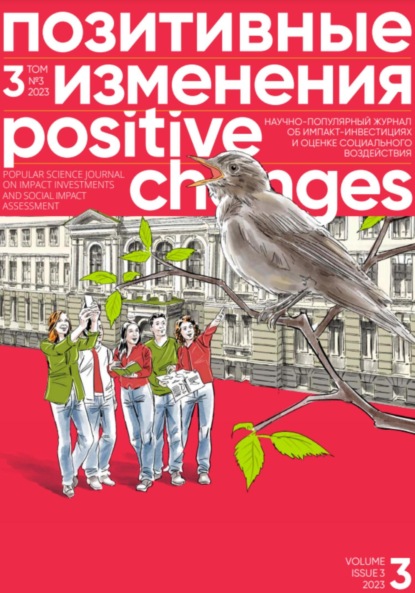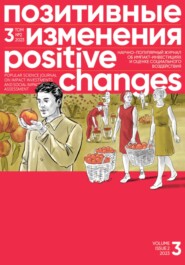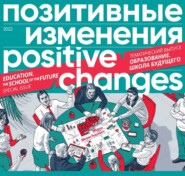По всем вопросам обращайтесь на: info@litportal.ru
(©) 2003-2024.
✖
Позитивные изменения. Том 3, № 3 (2023). Positive changes. Volume 3, Issue 3 (2023)
Настройки чтения
Размер шрифта
Высота строк
Поля
Юлия Вяткина
Редактор журнала «Позитивные изменения»
“The University Is a Development Institution That Can Become a Driver for Territorial Development.” Interview with Artem Shadrin
In many countries of the world, development institutions play a crucial role in implementing the social and economic policy of the state. They are tasked with fostering economic growth, facilitating modernization of the economy, and addressing urgent social issues. Outside the financial realm, however, universities play the key role of development institutions by providing invaluable expertise to government bodies, businesses, NGOs, social entrepreneurs, and local communities alike. To delve into today’s potential of universities and their evolving role as development institutions, we sat down with Artem Shadrin, Director of the Institute of Socio-Economic Design at the National Research University Higher School of Economics.
Artem Shadrin
How would you define the universities’ third mission? Why is it relevant to the universities? The third mission of a university encompasses activities aimed at fostering socio-economic development in cities and regions, as well as within specific sectors of the economy and the social sphere. It involves the integration of technological, social, and managerial innovations to drive progress.
The third mission is a natural complement to the university’s two primary missions: education and research. It plays a pivotal role in accelerating development within the regions where universities are located.
So, what are the key aspects of the third mission of universities, in your opinion?
Within the scope of the “Third Mission of the University” project,[23 - Project website: https://3mission.ru/.] which is led by the Institute of Socio-Economic Design at the National Research University Higher School of Economics and supported by the Vladimir Potanin Foundation, we have identified three primary focus areas.
The first focus involves positioning the university as an analytical hub, or think tank. This role entails universities actively participating in the formulation of social and economic development strategies cities and regions. It also encompasses creating and nurturing of territorial clusters, whether they are innovation-driven or creativity-oriented. Additionally, this aspect of the third mission involves conducting practice-oriented research and development activities.
Acting in this capacity, universities serve as highly effective communication platforms for stakeholders ranging from government bodies and businesses to NGOs and the media. They facilitate the formation of a shared vision for identifying and addressing developmental objectives, and formulating relevant scenarios.[24 - Ryazantseva, N. V., Borel, A. E. & Pashchenko, F. S. (2020). A research work report. Higher education institutions as regional think tanks. Retrieved from: https://clck.ru/35eMpe. (accessed: 11.09.2023).]
From this point of view, it is no coincidence that the Agency for Strategic Initiatives guided the establishment of the respective infrastructure in about four dozen Russian universities – the so-called “boiling points”.[25 - Leader ID. (2023). About the Boiling Point Network. Retrieved from: https://leader-id.ru/places/. (accessed: 11.09.2023).] These allow hosting a wide range of external events, from conferences and roundtable discussions to strategic planning and project sessions, by actively engaging faculty and students in the execution of these events.[26 - Boiling point. (2023). Boiling Points Handbook. Retrieved from: https://boilingpoint.rf2035.net/. (accessed: 11.09.2023).]
The second aspect is a partnership between the university and socially oriented non-governmental organizations in the implementation of joint projects and initiatives. Such organizations possess a deep understanding of the social issues affecting cities and regions, coupled with a strong motivation to address these challenges. Universities, in turn, bring to the table the latest advances in social and human sciences, cutting-edge practices in utilizing digital technologies, and provide valuable assistance in garnering necessary public support for these initiatives.
Finally, the third aspect centers around the integration of applied project-based learning mechanisms within university curricula. This approach complements traditional lecture and seminar formats. Under this model, students actively engage in practice-oriented projects that immerse them deeper in their chosen professions and create additional stimuli to obtain specialized professional competencies. Simultaneously, these projects develop essential soft skills, such as teamwork, time management, taking responsibility, and achieving tangible results.
This applied project-based learning format is gaining popularity in many engineering disciplines and, more recently, in various social science fields.[27 - The materials of the Russian National Best Practices in Project-Based Learning Contest for 2022 are available here: https://nark.ru/news/bc/konkurs-luchshih-praktik-2022/.] These projects give students an opportunity to earn a significant share of their academic credits, with the results being counted towards coursework and even final thesis requirements.
This practice lends substantial value to the students’ professional development, enabling them to independently or collaboratively implement socially or technologically significant projects using the knowledge and skills they have acquired.
Crucially, student project teams under the guidance of university professors have access to cutting-edge technologies, methodologies, and problem-solving approaches, along with the necessary time resources. In my opinion, this is what enables NGOs and social enterprises to gain a significant advantage by acting as the “social customers” of these projects.
One of the most prominent examples is the use of digital technologies in the promotional efforts of NGOs and social enterprises within the broader public sphere. Today’s students possess a unique advantage when it comes to navigating social media platforms, and for students majoring in media communications, this falls right within their realm of future professional expertise. This is one area in which students are often way more effective than most NGO staff.
Starting September, the service learning format has been piloted at a hundred universities. NGOs and social enterprises now have the opportunity to present their project assignments directly to universities or through the website of the Association of Volunteer Centers at Dobro.ru.[28 - Dobro.ru. (2023). Service Learning. Retrieved from: https://sl.dobro.ru/. (accessed: 11.09.2023).]
Are these three directions the same in the foreign universities, or do they have something that Russian higher learning institutions do not have? Both foreign and Russian universities largely pursue similar objectives within the context of the third mission. For example, a prevalent area within the third mission involves contributing to the resolution of socially significant challenges through the integration of modern technology solutions. These projects can be projects in areas like environment or developing assistive technologies for the handicapped, to name a few. Projects like this can be found in both foreign and Russian universities.
While Russia rightfully boasts its universities that rank near the top of the global scale in many aspects, the extent to which the third mission mechanisms are implemented in different Russian universities varies by several orders of magnitude. This split is clearly greater than the overall gap between leading Russian and foreign universities in this regard.
You mentioned the universities having the capacity to act as think tanks. How is this achieved in practice? Many of the strongest universities are contracted by government authorities, major corporations, development institutions, and charitable foundations to do research, analytical work, and provide consulting services. They also collaborate partner with non-governmental organizations (NGOs) in implementing grant projects. Some of these initiatives are conducted pro bono or as part of government assignments.
At the federal level, institutions like the Higher School of Economics, the Russian Academy of National Economy and Public Administration, Moscow State University, and the Finance Academy traditionally serve as leading expert organizations for the presidential administration, the government, and various federal ministries.
Some regional universities are also actively involved in analytical activities, such as Ural Federal University, Far Eastern Federal University, etc.
They serve as hubs attracting high-level experts and analysts with experience in both business and public service. Consequently, the practice of engaging universities in the development of conceptual documents for cities and regions is gaining traction.
What other contributions can universities make to the socio-economic development of their regions as part of their third mission?
In addition to acting as think tanks, one other notable approach is the cluster model, where universities can play an enhanced role in driving technological advancements in their regions. These clusters bring together businesses, research institutions, educational organizations, and development institutions.
In both Russian and foreign practice, universities often serve as the central organizations within these clusters. For instance, the D. Mendeleev University of Chemical Technology is the central organization of the “Green Moscow” interdisciplinary cluster,[29 - The D. Mendeleev University of Chemical Technology of Russia. (2023). The “Green Moscow” interdisciplinary industrial cluster. Retrieved from: https://www.muctr.ru/university/departments/cpirtk/klaster/. (accessed: 11.09.2023).] with the status of an innovative science and technology center. The university has also established an advanced engineering school as part of the cluster.
The Russian Ministry of Education and Science is actively promoting the creation of scientific and educational centers within several universities. These initiatives showcase the diversity of formats through which universities can harness their potential for regional development, with diverse contribution to socio-economic growth.
Three years ago, the Institute of Socio-Economic Design at NRU HSE launched a project to develop the universities’ third mission. What has the team achieved so far? How has the third mission evolved since?
We started with an analysis of the best practices both in Russia and abroad. Expert seminars were conducted to discuss the possibility of replicating these practices. Next, we trialed the integration of the third mission mechanisms in ten pilot universities. The result was a set of methodological recommendations,[30 - National Research University Higher School Of Economics. (2022). Building and upscaling the implementation practice of the university’s third mission. Methodological materials and model documents. Retrieved from: https://clck.ru/35A7hi. (accessed: 11.09.2023).] university internal regulations,[31 - National Research University Higher School Of Economics. (2022). Appendices to the methodological materials on building and upscaling the implementation practice of the university’s third mission. Retrieved from: https://clck.ru/35eN4L. (accessed: 11.09.2023).] and model “roadmaps” for each of the three main directions within the third mission activities. These were posted on the project’s website, 3mission.ru.
We are currently completing phase three, which is to scale the practice to as many universities as possible.
First, we launched an accelerator to support university projects, to help the third mission projects become a reality. The accelerator materials are available on the project’s website, which aims to assist all interested universities in launching project initiatives within the third mission.[32 - Accelerator website, program and materials: https://start.3mission.ru.]
Among the initiatives developed, which are presented on the accelerator’s website, is a project to support orphans and children without parental care, prepared by the Ural Federal University, projects to promote domestic tourism and creative industries, developed by teams from Murmansk and Petrozavodsk State Universities, and a number of others.
The team is currently working on a video course about the third mission. The course will describe the stages of organizing work within each of the three mission areas and will showcase interesting case studies from leading universities.
Second, taking into account the project results, we were actively engaged in developing methodological materials[33 - Methodological recommendations for the implementation of the “Service Learning” module in higher education organizations in the Russian Federation. (2023). Retrieved from: https://clck.ru/35JVAE. (accessed: 11.09.2023).] and training university representatives during the pilot launch of the “Service Learning” program in one hundred universities, together with colleagues from other departments of the Higher School of Economics and the Association of Volunteer Centers.
Another important event is the first All-Russian Forum on the universities’ third mission, which was held from late May to early June 2023 in Yaroslavl.[34 - The program, speakers, video from the forum “The Third Mission of the University: development problems and prospects” can be found here: https://3mission.ru/conf2023.]
Among other things, the Forum resulted in the establishment of a network of third mission specialists to exchange information between dedicated university staff and organizations interested in developing systemic partnership with the higher learning institutions.
What do the forms and ways of realizing the third mission in universities depend on?
First of all, they depend on the university’s staff and leadership. For example, to function as a think tank, a university needs staff with practice-oriented analytical expertise. Further, it is crucial that this activity receives systematic support from the university’s leadership.
How does the presence of a position towards the third mission change the university’s strategy and role for every staff member and student?
It offers students and staff opportunities for engagement in new areas, such as volunteer work, which is also part of the third mission. For the students, it provides a chance to collaborate on real-world projects, build valuable connections with the staff of partner organizations, such as NGOs or social enterprises.
The case can be particularly exciting when the partner company is a prospective future employer, engaging the students in joint volunteer projects that bridge the realms of university and corporate volunteering.
In such cases, participation in these projects serves as a valuable opportunity to cultivate informal connections with prospective colleagues in their future careers and gain firsthand insights into the intricacies of their professions.
Overall, engagement in university projects equips individuals with managerial skills and work experience that can prove valuable for graduates in the future. Besides, it is genuinely interesting. There is a marked difference between completing formal educational assignments, often devoid of real-world impact, and actively contributing to projects that genuinely address significant social challenges.
One notable example is the Faculty of Creative Industries at NRU HSE making social advertising videos as part of its NGO media accelerator project.[35 - National Research University Higher School of Economics (2022). LIME Accelerator. Retrieved from: https://lime.hse.ru/limeaks. (accessed: 11.09.2023).] Guided by film and animation professionals, students create viral videos based on briefs provided by NGOs and selected through a competitive process. This format is not only effective but also holds potential appeal for other universities.
Do third mission projects help to develop social entrepreneurship?
Absolutely. Let me give you some more examples within the framework of applied project-based learning. One notable instance is the Russian national competition for NGOs titled “Tell the World,” organized by NRU HSE in collaboration with the Agency for Social Investments and Innovations.[36 - ANO ASII. (2023). Tell the World. III All-Russian Contest of Assignments for Socially Oriented NGOs and Social Enterprises. Retrieved from: https://int-vol.ru/povedaimiru. (accessed: 11.09.2023).]
In this competition, NGOs and social enterprises serve as clients for student projects focused on developing marketing and communication strategies, product promotion strategies for social enterprises, market analysis, and the creation of brand guidelines to improve recognition for those organizations. A compelling catalog has been prepared to showcase the outcomes of these student projects.[37 - Anistratenko, O. B., Gaete Sepulveda, M. A., Maljova, U. I. & Sidlina, L. Z. Catalog of student projects developed by project participants for the development of intellectual volunteering. Retrieved from: https://int-vol.ru/#rec448505169. (accessed: 11.09.2023).]
Over the course of three years, more than one hundred projects have been selected through this competition. They encompass a wide range of intriguing initiatives, from the implementation of augmented reality technology for a city museum in Sverdlovsk Region to devising marketing strategies for the promotion of products made by social enterprises that employ individuals with disabilities.














